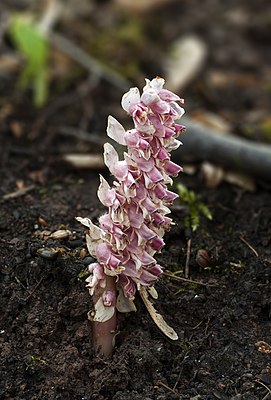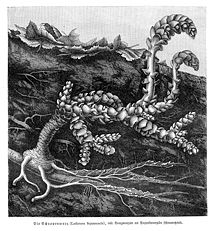Common pelvic root
| Common pelvic root | ||||||||||||
|---|---|---|---|---|---|---|---|---|---|---|---|---|

Scalyroot ( Lathraea squamaria ) |
||||||||||||
| Systematics | ||||||||||||
|
||||||||||||
| Scientific name | ||||||||||||
| Lathraea squamaria | ||||||||||||
| L. |
The common flake root ( Lathraea squamaria ), also upright flake root , is a plant species from the genus of the flake root ( Lathraea ) in the family of the summer root plants (Orobanchaceae).
description
The common shedroot is a perennial , herbaceous , almost chlorophyll- free parasite that forms a shoot about 10–30 cm high above ground .
The flowers are dull pink to purple in color and arranged in a one-sided, bent-over cluster .
Underground it forms a richly branched, up to 2 m long rhizome that can weigh up to 5 kg. The rhizome is covered with fleshy, starchy scales that represent transformed lower leaflets with a storage function.
The rhizome also has small suction organs ( haustoria ) with which the plant penetrates the tissue of trees or other host plants and sucks their sap there.
Since the psyllid does not form leaves, there is no transpiration suction that sucks the assimilates from the roots into the upper parts of the plant. The stem therefore has special water glands ( hydathodes ) that maintain the water potential between the host and the parasite by actively excreting or absorbing water.
The species chromosome number is 2n = 36 or 42.
Occurrence
The psyllid blooms from March to April immediately after the snow has melted, when the host trees are just starting to transport water. However, it does not mature until it is around 10 years old. The psyllid is found scattered all over Germany and is also found sporadically in other parts of Europe and West Asia. It is a Querco-Fagetea class character in Central Europe.
In the Allgäu Alps, it rises in Vorarlberg on the Vorderen Üntschenalpe near Schoppernau up to 1550 m above sea level.
Systematics
One can distinguish between two subspecies:
- Lathraea squamaria L. subsp. squamaria
- Lathraea squamaria subsp. tatrica Hadač : It occurs in Germany, Poland and Slovakia.
ecology
The flake root is a geophyte and survives the winter through its richly branched rhizome. She is a full-parasites (Holoparasit) and is considered one of the bleeding sap parasites (Xylemparasiten) because it occupies a special status under the holoparasites by the sap from the xylem taps of the hosts and not as usual only the phloem is tapped. Usually the xylem of the host plants, which are almost always trees, is lignified. However, since the xylem of the trees is saturated with organic compounds and plant sap in the spring, this enables the pelvic root to bloom in the spring. It parasitizes mainly on hazelnuts , alders , poplars , willows and beeches .
Pollinators are insects, especially bumblebees and (honey) bees . It is not uncommon for the pre-female ( proterogyne ) flowers to be pollinated by the wind ( anemophilia ). In unfavorable years, the flowers can also form underground. Pollination can then occur here without the flowers opening ( Kleistogamy ). The fruit set is always very high, almost all flowers develop into fruits.
The long-lived seeds must be closer than 1 cm to the host root in order to germinate. They are mostly spread by wind, water or ants.
etymology
The German name is derived from the fleshy, whitish, starchy storage scales on the rhizome . The botanical epithet squamaria also refers to the scales (Latin squama 'scales'). The generic name indicates that the plant is often largely hidden in the ground (Greek lathraios 'hidden').
literature
- Hans Christian Weber: Parasitism of flowering plants . Scientific Book Society, Darmstadt 1993, ISBN 3-534-10529-X .
- Hans Christian Weber: Schmarotzer: Plants that live on others . Belser, Stuttgart 1978, ISBN 3-7630-1834-4 .
- Job Kuijt: Biological and morphological notes on the systematic position of Lathraea. In: Contributions to the Biology of Plants 49 (1973), pp 137-146, ISSN 0005-8041 .
- Emil Heinricher: Monograph of the genus Lathraea. Gustav Fischer-Verlag, Jena 1931.
Individual evidence
- ^ Adler, Wolfgang., Oswald, Karl .: Excursion flora for Austria, Liechtenstein and South Tyrol: destination book for everyone in the Republic of Austria, in the Principality of Liechtenstein and in the autonomous province of Bolzano . 3rd, verb. u. exp. Edition of the "excursion flora of Austria." Upper Austrian State Museum, Linz 2008, ISBN 978-3-85474-187-9 .
- ↑ a b Erich Oberdorfer : Plant-sociological excursion flora for Germany and neighboring areas . 8th edition. Stuttgart, Verlag Eugen Ulmer, 2001. Page 862. ISBN 3-8001-3131-5
- ↑ Erhard Dörr, Wolfgang Lippert : Flora of the Allgäu and its surroundings. Volume 2, IHW, Eching 2004, ISBN 3-930167-61-1 , p. 479.
- ↑ a b Karol Marhold, 2011: Scrophulariaceae : Datasheet Lathraea squamaria In: Euro + Med Plantbase - the information resource for Euro-Mediterranean plant diversity.
- ↑ Hubert Ziegler: Lathraea, a bleeding juice parasite . In: Reports of the German Botanical Society 68 (1955), pp. 311-318.
- ↑ Hans Christian Weber: Comparative considerations on the subterranean organs of Lathraea squamaria L. and Tozzia alpina L. (Scrophulariaceae) . In: Contributions to the biology of plants , Volume 51 (1975), pp. 1-15, ISSN 0005-8041
Web links
- Common pelvic root. In: FloraWeb.de.
- Common pelvic root . In: BiolFlor, the database of biological-ecological characteristics of the flora of Germany.
- Profile and distribution map for Bavaria . In: Botanical Information Hub of Bavaria .
- Lathraea squamaria L. In: Info Flora , the national data and information center for Swiss flora . Retrieved March 22, 2016.
- Map of the entire area
- Thomas Meyer: Schuppenwurz data sheet with identification key and photos at Flora-de: Flora von Deutschland (old name of the website: Flowers in Swabia )



